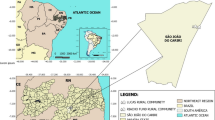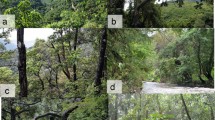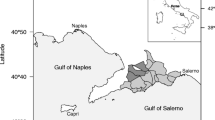Abstract
We present results of applying a simple technique to statistically test several hypotheses in ethnobotany, using plant use data from non-indigenous people in southeast Peru. Hypotheses tested concern: (1) the power of eight different variables as predictors of a plant’s use value; (2) comparisons of ethnobotanical knowledge among informants; and (3) the relationship between informant age and knowledge of plant uses. Each class of hypothesis is evaluated with respect to all uses, and classes (1) and (3) are evaluated for each of the following subsidiary use categories: construction, edible, commerce, medicine, and technology. We found that the family to which a plant belongs explains a large part of the variance in species’ use values. Each of the other factors analyzed (growth-form, density, frequency, mean and maximum diameter, mean and maximum growth rate) is also significantly predictive of use values. Age significantly predicts informant knowledge of(l) all uses, and (2) of medicinal uses. Plant medicinal lore is particularly vulnerable to acculturation.
Resumen
Presentamos los resultados de la aplicación de una simple técnica cuantitativa, descrita anteriormente, para probar estadisticamente algunas hipotesis etnobotánicas. Usamos datos de los usos de plantas por los mestizos del Sur-Este del Peru. Las hipótesis que nos conciernen están relacionadas con: (1) el poder de ocho factores diferentes para pronosticar la utilidad de plantas; (2) el nivel del conocimiento etnobotánico entre informantes; y (3) la influencia de la edad del informante para pronosticar la varianza en el conocimiento de usos de plantas. Se evalua cada hipotesis con respecto a todos los usos, y se evalua las hipotesis (1) y (3) para cada una de la categorias de uso: construcción, comestibles, comerciales, medicinales, y tecnologicos. Concluimos que la familia a la cual pertenece una planta afecta el valor de su utilidad, y explica en parte la varianza de los valores de utilidad. Cada uno de los otros factores analizados (forma de crecimiento, densidad, frecuencia, diámetro promedio y máximo, tasa de crecimiento promedio y máximo) también pronostican significativamente los valores de utilidad. La edad es un buen pronosticador del conocimiento de todos usos, y de usos medicinales. Sin embargo, informantes de edades similares pueden tener niveles de conocimiento muy diferentes. El conocimiento de plantas medicinales es más suceptible a la aculturacción que el conocimiento de las otras categorias de uso.
Similar content being viewed by others
Literature Cited
Adu-Tutu, M., Y. Afful, K. Asante-Appiah, D. Lieberman, J.B. Hall, and M. Elvin-Lewis. 1979. Chewing stick usage in southern Ghana. Economic Botany 33:320–328.
Balee, W.A. 1989. The culture of Amazonian forests. Advances in Economic Botany 7:1–21.
—. 1990. Resin classification by the Ka’apor Indians. Advances in Economic Botany 8:24–34.
Berlin, B., D. E. Breedlove, and P. H. Raven. 1974. Principles of Tzeltal plant classification. Academic Press, New York.
—. 1990. The chicken and the egg-head revisited: further evidence for the intellectualist bases of ethnobiological classification. Pages 19–33in D. A. Posey and W. L. Overal, eds., Ethnobiology: implications and applications. Museu Paraense Emilio Goeldi, Belém, Brazil.
Feeny, P. 1976. Plant apparency and chemical defense. Recent Advances in Phytochemistry 10:1–40.
Gentry, A. H. 1992. A synopsis of Bignoniaceae ethnobotany and economic botany. Annals of the Missouri Botanical Garden 79:53–64.
-. n.d. Tropical forest biodiversity and the potential for new medicinal plants.In A. Kinghorn, ed., Human medicinal agents from plants.
Hays, T. E. 1982. Utilitarian/adaptationist explanations of folk biological classification: some cautionary notes. Journal of Ethnobiology 2:89–94.
Hegarty, M. P., E. H. Hegarty, andA. H. Gentry. 1991. Secondary compounds in vines with an em-phasis on those with defensive functions. Pages 287- 310in F. Putzand H. A. Mooney, eds., The biology of vines. Cambridge University Press, Cambridge, England.
Hnnn, E. 1982. The utilitarian factor in folk biological classification. American Anthropologist 84:830–847.
Johns, T., J. O. Kokwaro, and E. K. Kimanani. 1990. Herbal remedies of the Luo of Siaya District, Kenya: establishing quantitative criteria for consensus. Economic Botany 44:369–381.
Lewis, W. H., M. Elvin-Lewis, and M. C. Gnerre. 1987. Introduction to the ethnobotanical pharmacopeia of the Amazonian Jivaro of Peru. Pages 96–103in A. J. M. Leeuwenberg, ed., Medicinal and poisonous plants of the tropics. Pudoc Wageningen, The Netherlands.
— 1991.Pentagonia gigantifolia (Rubiaceae) as a snakebite remedy: empirical methodology functioning in Amazonian traditional medicine. Economic Botany 45:137–138.
Moerman, D. E. 1979. Symbols and selectivity: a statistical analysis of Native American medicinal ethnobotany. Journal of Ethnopharmacology 1:111–119.
—. 1991. The medicinal flora of native North America: an analysis. Journal of Ethnopharmacology 31:1–42.
Padoch, C, and W. de Jong. 1992. Diversity, variation, and change in ribereño agriculture. Pages 158–174in K. H. Redford and C. Padoch, eds., Conservation of Neotropical forests. Columbia University Press, New York.
Paz y Miño C, G., H. Balslev, R. Valencia R., and P. Mena V. 1991. Lianas utilizadas por los indigenas Siona-Secoya de la Amazonia del Ecuador. Reportes Técnicos 1. Ecociencia, Quito, Ecuador.
Phillips, O.L.B. 1991. The ethnobotany and ecology of tropical vines. Pages 427–475in F. Putz and H. A. Mooney, eds., The biology of vines. Cambridge University Press, Cambridge, England.
—,and A. H. Gentry. 1993. The useful plants of Tambopata, Peru: I. Statistical hypotheses tests with a new quantitative technique.Economic Botany 47:15–32.
Popper, K. R. 1963. Conjecture and refutations: the growth of scientific knowledge. Harper and Row, New York.
Prance, G. T., W. Balee, B. M. Boom, and R. L. Carneiro. 1987. Quantitative ethnobotany and the case for conservation in Amazonia. Conservation Biology 1:296–310.
Turner, N. J. 1988. The importance of a rose: evaluating the cultural significance of plants in Thompson and Lilloet Interior Salish. American Anthropologist 90: 272–290.
Author information
Authors and Affiliations
Rights and permissions
About this article
Cite this article
Phillips, O., Gentry, A.H. The useful plants of Tambopata, Peru: II. Additional hypothesis testing in quantitative ethnobotany. Econ Bot 47, 33–43 (1993). https://doi.org/10.1007/BF02862204
Received:
Accepted:
Issue Date:
DOI: https://doi.org/10.1007/BF02862204




